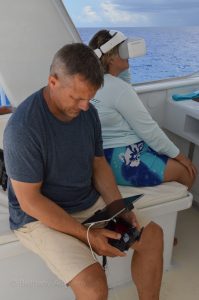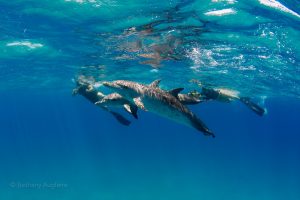Trip 2017-04 (June 20th – June 29th)
What is the most difficult part of studying dolphin acoustic communication you ask? Well, it’s really quite difficult to determine who is vocalizing on the underwater video. Because we are in the water and swim along with the dolphins as they are behaving, we need a mobile device that helps us track and localize sounds. If we were working from the surface, or from shore, we could deploy hydrophones at a distance and create a situation to localize sounds (like terrestrial researchers can do). But this simply does not work for us. Our long-term colleague, Matthias Hoffmann-Kuhnt, from the National University of Singapore, has been working on a mobile underwater device, ASPOD (Acoustic Source Position Overlay Device) which allows tracking of a vocalizing dolphin underwater. So much of our trip was devoted to playing with and sampling dolphin behavior to get data for this work.
Another great toy we had onboard was a drone. We have been experimenting with how useful a drone is for our work. Our initial thoughts were to have a drone expand our search area, however between the limited distance range and small visual images at altitude, it looks like our best use of the drone is to follow dolphins that we can see near the boat traveling. Sometime we follow pods of dolphins at a distance to see where they go. The drone offers the advantage of seeing the dolphins and also the habitat they are navigating through, which in the Bahamas is usually quite visual. This no doubt will be a tool for the future.

Matthias controls the drone while Dr. Herzing watches the habitat go by real time with the help of a virtual reality mask.
– Dr. Denise Herzing, Research Director, WDP
What does our underwater world look and sound like? There are plenty of videos here.

